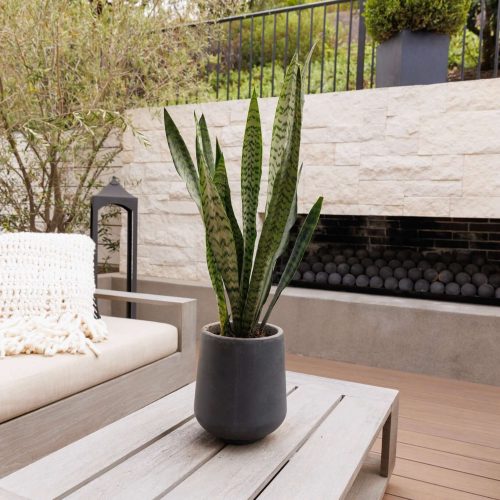Can a Snake Plant Live Outside or would it be a good idea to keep them indoors? If you are confused, then we have the answers!
Can a Snake Plant Live Outside? – The question isn’t just if it can survive, but how it might actually thrive and bring a new level of elegance to your garden landscape. Let’s find out!
Check out details about black dragon snake plant here
Can a Snake Plant Live Outside?
The simple answer is yes, you can keep snake plants (Sansevieria) outside, but with some caveats. Snake plants are incredibly hardy and adaptable; however, their suitability for outdoor placement depends on various factors:
Climate Conditions
- Temperature: Snake plants are tropical plants that prefer temperatures between 70-90°F (20-32). They can tolerate cooler temperatures, but anything below 50°F is not advisable, as it could lead to root rot or other damage.
- Hardiness Zones: Generally suitable for USDA hardiness zones 9-11, if you live in a cooler zone, consider bringing the plant inside during colder months.
Sunlight Requirements
- Direct Sunlight: Snake plants are highly adaptable to different light conditions. They can tolerate direct sunlight but also do well in partial shade.
- Light Duration: A minimum of six hours of light exposure is generally recommended for optimum growth.
Find out all the differences between aloe vera and snake plants here
Can a Snake Plant Live Outside – Different USDA Zones
USDA Zone 11
- Yes: In Zone 11, the climate is tropical, and temperatures rarely dip below 40°F. Snake plants thrive in these conditions.
USDA Zone 10
- Yes: Temperatures usually remain above 30°F, making it a suitable climate for snake plants. However, take care to protect them from excessive moisture.
USDA Zone 9
- Yes: This zone also provides a mostly warm climate where snake plants can thrive. However, there may be occasional frosts, so be prepared to bring the plants inside or provide frost protection.
USDA Zone 8
- Conditional Yes: The temperature can drop below freezing in winter. Outdoor placement is possible in the warmer months, but you’ll need to bring the plant inside when colder temperatures arrive.
USDA Zone 7
- No: Regular frost and temperatures that can dip down to 0°F make it a high-risk zone for outdoor placement of snake plants.
USDA Zone 6
- No: The climate is too cold for a tropical plant like the snake plant to survive outdoors year-round.
USDA Zone 5
- No: With temperatures that can go as low as -20°F, this zone is definitely not suitable for snake plants to stay outdoors year-round.
Do snake plants need drainage holes in the pot? Find out here
Factors to Consider When Keeping a Snake Plant Outside in USDA Zones 8-11
1. Temperature
- Zones 9-11: Generally safe for outdoor snake plant placement year-round.
- Zone 8: Monitor weather forecasts, especially during winter, and bring plants inside if frost or temperatures below 50°F are expected.
2. Light Exposure
- Full Sun to Partial Shade: Snake plants are quite adaptable but aim for a location with a minimum of six hours of light exposure. However, in very hot climates, some afternoon shade can be beneficial.
3. Soil Conditions
- Well-Drained Soil: Opt for sandy, well-drained soil. Poorly drained soil can lead to root rot.
- Soil pH: Snake plants prefer a slightly acidic to slightly alkaline soil with a pH range of 6-7.
4. Watering Schedule
- Infrequent Watering: Let the soil dry out between waterings. Overwatering can lead to root rot, especially in humid conditions.
- Rainfall: In Zones 9-11, natural rainfall might suffice, but in Zone 8, you may need to supplement, especially in dry spells.
5. Wind and Storms
- Wind Resistance: Snake plants have sturdy leaves but can be susceptible to strong winds. Choose a sheltered location if your area is prone to heavy winds.
- Storm Precautions: During extreme weather events, consider bringing your snake plant indoors or providing some sort of physical protection.
6. Pest and Disease Management
- Pests: While generally pest-resistant, outdoor snake plants may attract snails and slugs. Use natural repellents or barriers if needed.
- Disease: Mostly resistant to diseases, but poor soil and water management can lead to root rot.
7. Seasonal Transitions
- Zone 8: As winter approaches, prepare to transition the plant indoors.
- Zones 9-11: Generally okay to leave outside but monitor for extreme weather conditions.
8. Fertilization
- Low Nutrient Needs: Snake plants don’t require frequent fertilization. A balanced, slow-release fertilizer applied in the growing season (spring and summer) should suffice.




